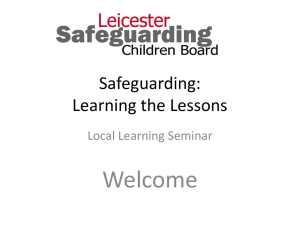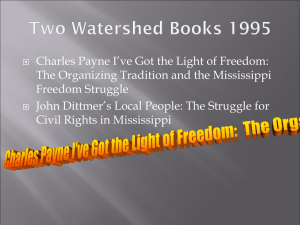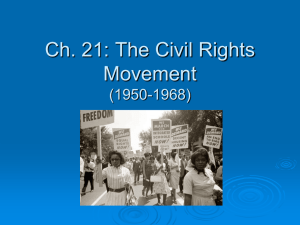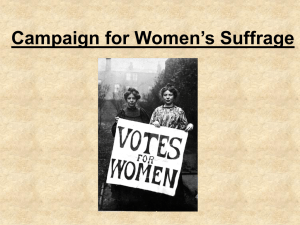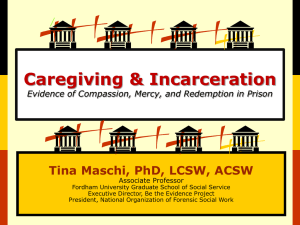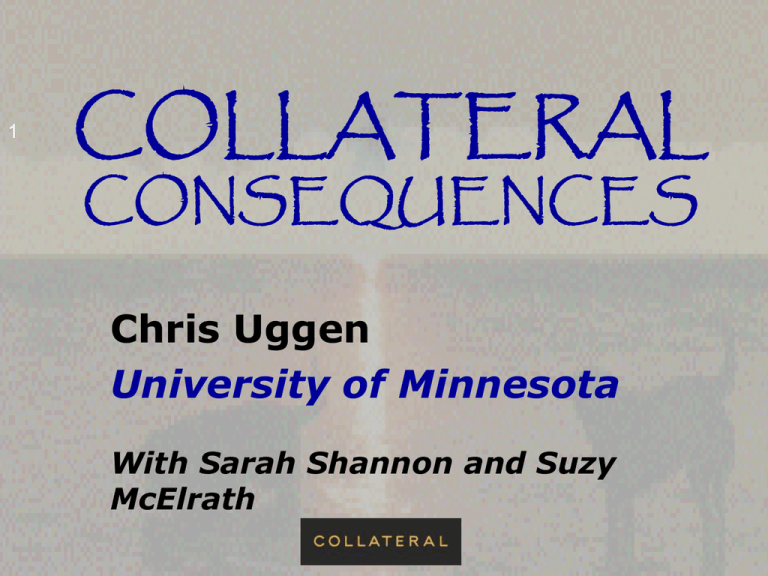
1
COLLATERAL
CONSEQUENCES
Chris Uggen
University of Minnesota
With Sarah Shannon and Suzy
McElrath
consequences of consequences
2
• social facts and social choices
– numbers and pictures
– justice and public safety
– opportunity
• “America’s Criminal Class”
– defined by punishment and relation between
individual and state, not offending
– “ex-prison” v. “ex-felon” v. “low-level” distinction
• consequences have consequences
– political and civic life
– work and markets
– personal and community health
10/19/12 Uggen
2
3
Part I
VISUALIZING
PUNISHMENT
(W/ SARAH SHANNON)
10/19/12 Uggen
3
1. Prisoners
Incarceration in global perspective
4
10/19/12 Uggen
4
2. “felons”
5
• current: 4.2 million
– current prison, parole, felony probation,
convicted felony jail population
– 1.8% of adult voting age population
– 5.0% of African American adults (decline)
• ex: 16.2 million
– 6.9% of adults
– 18.2% of African American adults
• total: 20.4 million in 2010
– 8.7% of adult population
– 23% of African American adults
10/19/12
Uggen of African American adult males
– 33%+
5
growth of felons and ex-felons, 1948-2010
25,000,000
6
20,000,000
15,000,000
10,000,000
5,000,000
-
10/19/12 Uggen
Ex-Felons
Current Felons
6
1980 ex-felons
7
10/19/12 Uggen
7
2010 ex-felons
8
10/19/12 Uggen
8
1980 African American ex-felons
9
10/19/12 Uggen
9
2010 African American ex-felons
10
10/19/12 Uggen
10
2010 African American “current” felons
11
10/19/12 Uggen
11
12
Part II
COLLATERAL
SANCTIONS AS
DIRTY BOMBS
10/19/12 Uggen
12
collateral consequences
(Ewald & Uggen 2012)
13
• Socioeconomic
–
–
–
–
–
Occupational licensure (character+)
Public employment
Pell grants (drug)
Public assistance (drug)
Driver’s licenses (drug)
• Family
– Public housing (drug; sex)
– Parental rights
– Divorce
• Civic
– Voting
– Juror
– Military
– Internet record
– Deportation
10/19/12 Uggen
13
“dirty bomb” analogy
14
• Weapons of mass disruption
– Conventional punishment, plus a small amount of
radioactive material
– Induces fear and panic, contaminates broadly, and
necessitates massive cleanup
• Pare back egregious (e.g., lifetime bans)
– Like addressing radiation sickness, but not water
contamination or building safety
– Padilla v. Kentucky (2010); integral, not “collateral”
• Utopian
– impose at sentencing on individual, crime-specific basis
– retain “checklist”
10/19/12 Uggen
14
how many are disenfranchised?
15
10/19/12 Uggen
15
who is disenfranchised?
16
10/19/12 Uggen
16
where are the disenfranchised?
17
10/19/12 Uggen
17
the picture in 1980
18
10/19/12 Uggen
18
2010 cartogram
19
10/19/12 Uggen
19
African American Disenfranchisement, 1980
20
10/19/12 Uggen
20
African American Disenfranchisement, 2010
21
10/19/12 Uggen
21
reforms 1997-2010
22
• 9 states repealed or scaled back lifetime
bans
• 2 states (Connecticut and Rhode Island)
extended voting rights to persons under
probation or parole supervision
• 8 states eased restoration process after
completion of sentence
---------------------------------------------• 800,000 citizens regained voting rights
10/19/12 Uggen
22
in Oregon, voting probationers and parolees
have significantly lower recidivism rates
23
10/19/12 Uggen
23
24
Part III
COMMUNITY
SPILLOVER
10/19/12 Uggen
24
effects on elections
25
• Potential impact of 5.85 million
disenfranchised:
– 7 U.S. Senate seats [VA, TX, KY, FL,
GA, KY, FL +/- WY]
– 2 Presidential elections
– Shifts debate on other issues
10/19/12 Uggen
25
public assistance bans (with Thompson and Western)
26
10/19/12 Uggen
26
27
10/19/12 Uggen
27
28
10/19/12 Uggen
28
deportation
King
and
Figure 1: (with
Criminal Deportations
by Year,
1908-2005Massoglia)
45000
60
29
40000
Number of Criminal Deportations
35000
30000
40
25000
30
20000
15000
20
10000
10
5000
0
1908
0
1918
1928
1938
1948
1958
1968
1978
1988
1998
Year
10/19/12 Uggen
Number of criminal deportations
Criminal as a percentage of all deportations
29
Criminal as a Percentage of All Deportations
50
criminal deportation & unemployment
30
10/19/12 Uggen
30
health effects
31
• Prison effects on community health
depend on prison care
– public health benefit where prisons are testing
and treating (TB, syphilis)
– continuity of care after release
• Spillover effects on community
–
–
–
–
diminished access to care
less access to specialists
reduced physician trust
less satisfaction with care
10/19/12 Uggen
31
32
Part IV
CLEAN UP LOW-LEVEL
GARBAGE CASES
10/19/12 Uggen
32
low-level arrest
33
annual arrest v. imprisonment rate per
1000, Minnesota 2007
250
227
200
158
150
100
50
32
29
1
1
Asian
White
0
12
Indian/Alaskan
14
African
American
annual arrest rate per 1000 population
imprisonment rate per 1,000
10/19/12 Uggen
33
34
10/19/12 Uggen
34
our moment
35
• proliferation of low-level “records”
– big change in dissemination and use
– at least half of employers routinely checking
• do employers really care about 3year old disorderly conduct arrests?
– Yes – run screaming from any negative signal
– No – too commonplace and/or honesty effect
• should we “ban the box”?
– threshold (arrest v. conviction)
– severity (misdemeanor v. felony)
– duration (7 years v. life)
10/19/12 Uggen
35
callbacks by race and record
38.8
40
34.7
35
27.5
30
23.5
callback %
36
45
25
20
15
10
5
0
white
no misdemeanor arrest
10/19/12 Uggen
black
misdemeanor arrest
36
modest but measurable
37
• low-level arrest w/o charge or conviction
– employers attend to the lowest-level records:
4% difference; not disqualifying
– personal contact swamps other predictors
• expungement as partial relief
– burdensome and costly process
• real utopia?
– introducing record at “finalist” stage (MN)
– avoiding records in first place; new social
welfare and community service institutions
10/19/12 Uggen
37
arrest and feeling on time
(MN 30-year-olds)
38
10/19/12 Uggen
38
39
10/19/12 Uggen
39
40
Part V
“CONSEQUENCING”
SMARTER
easier said than done
41
• Focused and effective response to
crime
1. Reserve prison beds for those who need to be
in prison, when they need to be in prison
2. Reduce the scope and number of
unnecessary collateral sanctions
3. Redirect low-level offenses away from
criminal justice system
• Reintegration
– from prison, to community corrections, to
taxpaying citizen in good standing
10/19/12 Uggen
41
800
Crimes Known to the Police, US 1990-2010
5,000
700
violent (right axis)
42
rate per 100,000 population
4,500
property (left axis)
600
4,000
3,500
500
3,000
400
2,500
300
rate per 100,000 population
5,500
2,000
200
1,500
1,000
100
2010
2009
2008
2007
2006
2005
2004
2003
2002
2001
2000
1999
1998
1997
1996
1995
1994
1993
1992
1991
1990
10/19/12 Uggen
42
US Criminal Victimization, 1990-2010
Property victimization rate per 1,000 households
300
43
250
60
50
property (left axis)
violent (right axis)
40
200
30
150
20
100
10
50
0
Violent Victimization rate per 1,000 persons age 12 or
older
350
0
2010
2009
2008
2007
2006
2005
2004
2003
2002
2001
2000
1999
1998
1997
1996
1995
1994
1993
10/19/12 Uggen
43
supplemental
44
10/19/12 Uggen
44
pragmatic note
45
• JQ Wilson critique
– When social scientists were asked for advice by
national policy-making bodies they could not respond
with suggestions derived from and supported by their
scholarly work.
• getting our hands dirty
– need knowledge and sophistication about how the
criminal justice system actually works: health impact
– capacity to imagine and enact alternatives
• identifying real models
– Documentation is fine, but… we need clear-headed,
rigorous, viable answers
10/19/12 Uggen
45
growth of people “on paper”
7000000
6000000
5000000
Parole (12%)
4000000
Prison (21%)
Jail (11%)
3000000
2000000
Probation (57%)
1000000
Parole (12%)
10/19/12 Uggen
Prison (21%)
Jail (11%)
Probation (57%)
46
2010
2009
2008
2007
2006
2005
2004
2003
2002
2001
2000
1999
1998
1997
1996
1995
1994
1993
1992
1991
1990
1989
1988
1987
1986
1985
1984
1983
1982
1981
0
1980
46


